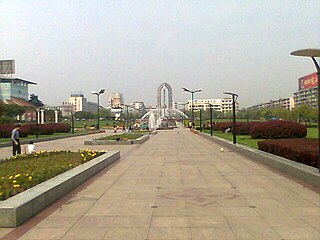Administrative division
The subdistrict is divided into 9 villages and 7 community, the following areas: Zhongxinlu Community, Zhajiawan Community, Zhujiayan Community, Yanxing Community, Caojiabao Community, Yanzhonglu Community, Yanjia Community, Shipan Community, Shimen Community, Shaxi Village, Shatang Village, Baishi Village, Jinlong Village, Longmen Village, Shizi Village, and Sanguan Village (中心路社区、查家湾社区、朱家岩社区、晏兴社区、曹家堡社区、晏中路社区、晏家社区、石盘村、石门村、沙溪村、沙塘村、白石村、金龙村、龙门村、十字村、三观村).
A residential community is a community, usually a small town or city, that is composed mostly of residents, as opposed to commercial businesses and/or industrial facilities, all three of which are considered to be the three main types of occupants of the typical community.

Hejian is a county-level city under the administration of the prefecture-level city of Cangzhou, in the east-central part of Hebei province, China. As of 2004, the population was ca. 770,000 inhabitants and the city territory was 1,333 km2 (515 sq mi). Hejian is situated along China National Highway 106.

Wujiagang District is a district of the city of Yichang, Hubei, People's Republic of China. Established in 1986, the territory of the whole area is 84.03 square kilometers. There are 33 community neighborhood committees in 4 Street offices and 16 village committees in 1 townships, with a total population of 214194 at the end of 2010. Wujiagang district is the old industrial district of Yichang City, with a large quantity of high quality industrial stock. There are more than 300 enterprises, enterprises and enterprises in the District, and the industrial output value accounts for more than 70% of the total industrial output value of the city's urban areas. By the end of 2013 has formed the Jinshan building materials, non-staple food, vegetables and fruits, Hengchang bridge Ding Xin auto parts, automobile trade city, Three Gorges building materials City, home run supermarket market clusters, all kinds of professional market reached 32, the business area of more than 16 square meters.

Hehua Subdistrict is an urban subdistrict in Liuyang City, Hunan Province, People's Republic of China. As of the 2015 census it had a population of 46,700 and an area of 134-square-kilometre (52 sq mi). The subdistrict is bordered to the north by Guankou Subdistrict, to the northeast by Gaoping Town, to the southeast by Chengtanjiang Town, to the northwest by Jili Subdistrict, to the southwest by Chengchong Town, and to the south by Dayao Town.

Shimashan Town is an urban town in Lianyuan, Loudi City, Hunan Province, People's Republic of China.

Dabuqiao Subdistrict is a subdistrict in Louxing District of Loudi City, Hunan Province, People's Republic of China.

Luguan Town is an urban town in Xinhua County, Loudi City, Hunan Province, People's Republic of China.

Wentang Town is an urban town in Xinhua County, Loudi City, Hunan Province, People's Republic of China.

Taohuajiang Town is a town and the seat of Taojiang County in Hunan, China. It was reformed through the amalgamation of Huaguoshan Township, Niutanhe Township and the former Taohuajiang Town in 2005. The town is located in the east of the county, it is bordered by Xinqiaohe Town of Ziyang District and Xiushan Town to the north, Huilongshan Subdistrict, Xielingang Town and Xinshidu Town of Heshan District to the east, Shiniujiang Town to the south, Gaoqiao and Fuqiushan townships to the west. It covers an area of 179.685 km2 (69.377 sq mi) with a population of 156,286, the town has 21 villages and 10 communities under its jurisdiction.

Qingtangpu Town is an urban town in Anhua County, Yiyang, Hunan Province, People's Republic of China.
Shuiximen is a subdistrict and the seat of Wugang City in Hunan, China. It was one of four subdistricts approved to establish in 1994 and officially created in 2011. The subdistrict has an area of 83.1 km2 (32.1 sq mi) with a population of 64,000. The subdistrict of Shuiximen has 14 villages and 5 communities under its jurisdiction. Its seat is Desheg Village.
Yuhe Subdistrict is a subdistrict and the seat of Qidong County in Hunan, China. It was one of four subdistricts approved to establish in 2014. The subdistrict has an area of 60.09 km2 (23.20 sq mi) with a population of 69,800. The subdistrict of Yuhe has 7 villages and 7 communities under its jurisdiction, its seat is at Yongchang Avenue.

Guanshaling Subdistrict is a subdistrict of Yuelu District in Changsha, Hunan, China. The subdistrict has an area of about 14.17 km2 (5.47 sq mi) with a population of 51,324. The subdistrict of Guanshaling has 3 villages and 13 communities under its jurisdiction, its administrative office is at Juzhou Xinyuan Community.

Meixihu Subdistrict is a subdistrict of Yuelu District in Changsha, Hunan, China. It was approved to form from a part of Tianding Township in April 2007. The subdistrict has an area of 20.2 square kilometres (7.8 sq mi) with more than households of 29,359 and a permanent residential population of about 20,000. As of 2017, the subdistrict has 2 villages and 6 communities under its jurisdiction, its seat is Jiashun Community. The subdistrict is home and the core zone of Xiangjiang New Area.

Juzizhou Subdistrict is a subdistrict of Yuelu District in Changsha, Hunan, China. It is historically the Shuiluzhou Subdistrict formed in 1950s. The subdistrict has an area of 16.02 square kilometres (6.19 sq mi) with a permanent resident population of about 168,000. The subdistrict has 2 villages and 8 communities under its jurisdiction.

Wangchengpo Subdistrict is a subdistrict of Yuelu District in Changsha, Hunan, China. It was formed in 1998. The subdistrict has an area of 4.96 square kilometres (1.92 sq mi) with a permanent population of about 80,000. The subdistrict has 10 communities under its jurisdiction.







